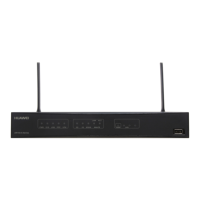6.1 Auto-Config Overview
This section describes the functions and advantages of Auto-Config.
Auto-Config Functions
When a new or unconfigured router is powered on, a version file, patch file, and configuration
file must be loaded to the router. If routers are located dispersedly, the maintenance personnel
have to manually configure each router, which requires a heavy workload. The Auto-Config
function implements remote device configuration and reduces maintenance costs. The routers
running Auto-Config automatically downloads version file, patch file, and configuration file.
Auto-Config Advantages
Maintenance personnel do not need to manually configure each device. Auto-Config simplifies
network configurations and implements unified management and remote debugging on routers.
6.2 Auto-Config Features Supported by the AR150/200
This section describes the intermediate file, Option parameters, and process of Auto-Config
supported by the AR150/200.
NOTE
Auto-Config deployment and USB deployment are mutually exclusive.
Intermediate File
The intermediate file arnet.ini is used in the Auto-Config process. The intermediate file records
the mappings between the router's MAC address (or ESN) and system software name, version
number, patch file name, and configuration file name. If the version file, patch file, and
configuration file are stored on the FTP or TFTP server, its system software name extension
must be .cc, the patch file name extension must be .pat, and the configuration file name extension
must be .zip or .cfg. After the router obtains the IP address of the FTP or TFTP server, it
downloads the file arnet.ini from the FTP or TFTP server to search for the names of the required
system software, version number, patch file, and configuration file, and then downloads files
from the FTP or TFTP server.
NOTE
Auto-Config uses Option 67 to obtain the configuration file first. If Option 67 is not configured, Auto-
Config obtains the intermediate file.
Each row in the intermediate file describes a device. The intermediate file contains information about a
maximum of 1000 devices.
For example, if the MAC address of an AR150/200 is 0018-82C5-AA89, the ESN is
9300070123456789, the system software name is auto_V200R001C00.cc, the version is
V200R001C00, the patch file is auto_V200R001C00.pat, and the configuration file is
auto_V200R001C00.cfg, the contents of the intermediate file arnet.ini are as follows:
MAC=0018-82C5-
AA89;ESN=9300070123456789;vrpfile=auto_V200R001C00.cc;vrpver=V200R001C00;patchfile
=auto_V200R001C00.pat;cfgfile=auto_V200R001C00.cfg;
Huawei AR150&200 Series Enterprise Routers
Configuration Guide - Device Management 6 Auto-Config
Issue 02 (2012-03-30) Huawei Proprietary and Confidential
Copyright © Huawei Technologies Co., Ltd.
96

